Forecasting
dust storms
Using CAMS data to predict
dust transport from the Sahara
to Europe

From time to time, usually in spring and summer, Europe witnesses deep red sunsets and snow turning orange; clothes drying outside and cars getting dirty. This is caused by particles of dust from arid or semi-arid regions, such as the Sahara in Africa, being blown over the Mediterranean and spreading across much of southern and central Europe. In exceptional conditions, the dust can travel even further – reaching as far as the United Kingdom and Scandinavia, and also cross the Atlantic to the Caribbean.
The dust is a visible example of air pollution. It is harmful to human health and can cause or aggravate many respiratory diseases, as well as cardiovascular disease and meningitis. It can affect agricultural output; disrupt air, road and rail transport; and cover solar panels, reducing their effectiveness at producing energy. Effective management can help those in the solar energy sector not only protect their existing infrastructure, but plan where to build new plants.
All these business sectors, as well as policymakers, are keen to know when dust will arrive. The Copernicus Atmosphere Monitoring Service (CAMS) provides forecasts to help these organisations and citizens plan to avoid or mitigate the effects of dust storms.
Forecasting dust
Maintaining air quality
Large-scale weather patterns are responsible for transporting the dust across countries and even continents. This is how dust from the Sahara has so much impact on Europe.
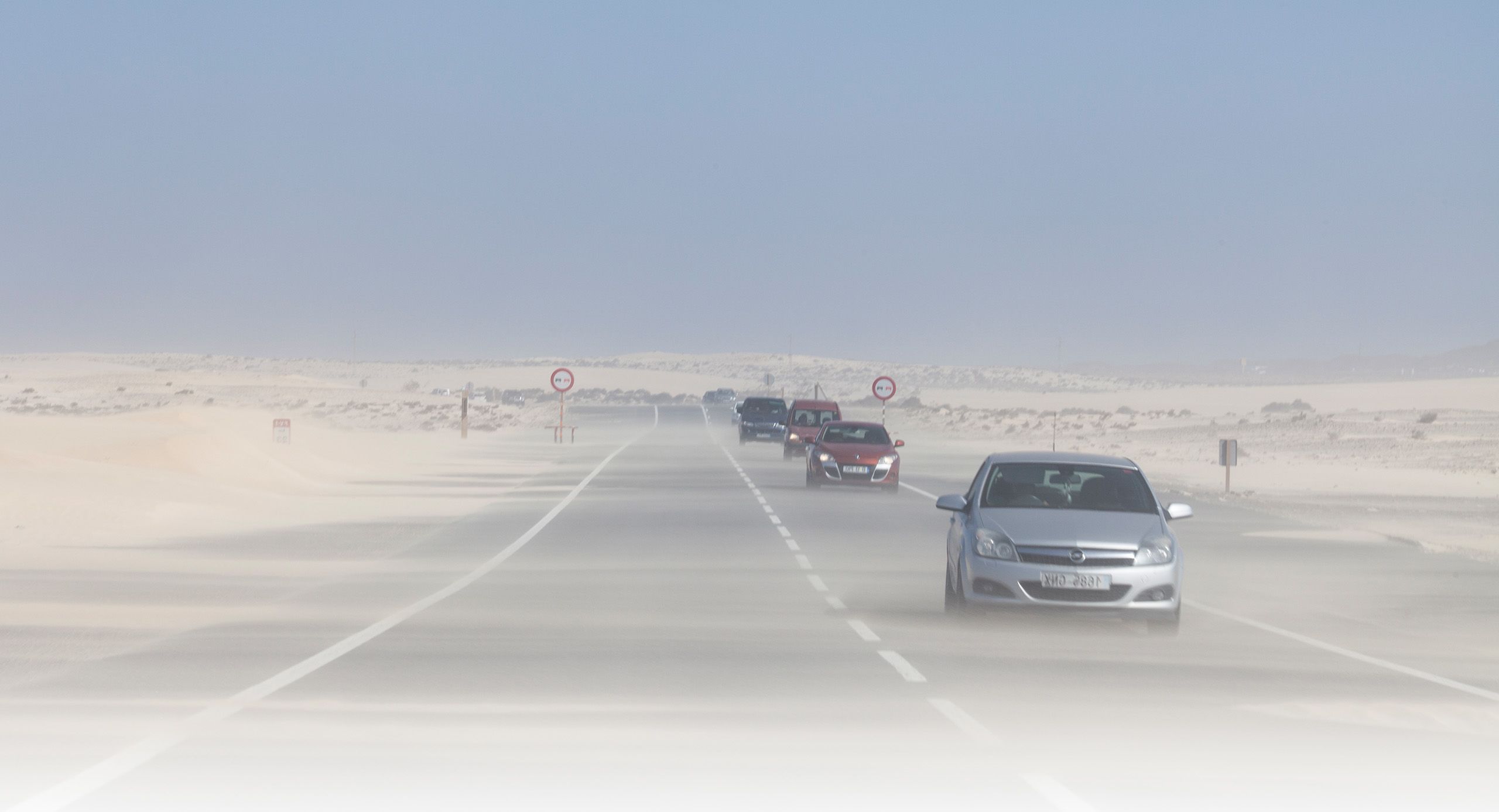
Dust comprises small particles of loose soil and sand.
The particles are lifted into the atmosphere by gusts of surface winds and can be transported and deposited thousands of kilometres away.

This transport is vital to the functioning of many ecosystems; for example, feeding marine organisms at the base of many food webs.
However, the settling of dust can affect economic sectors, such as agriculture; when dust lands on crops, it can limit photosynthesis and impact yield. Transport can also be affected; dust can damage aircraft and, when it lands on railway tracks and overhead lines, train operations are affected.
Knowledge of dust deposition could also be used by entities that monitor air quality and enforce mitigation measures. For example, it can be helpful to dampen roads before dust falls, so cars do not disturb the settled dust and affect the quality of the air we breathe. However, because dust is a natural component of particulate matter, taking measures such as temporarily reducing road traffic ahead of an air pollution event have little impact.
Many sectors can benefit from CAMS forecasts of dust movement and concentrations in the air.
CAMS draws on a network of satellites and ground-based sensors, as well as high-performance computer modelling of the atmosphere, to create forecasts of dust. These daily forecasts offer a snapshot of the air quality and enable those who must respond to dust deposition events to plan.
CAMS aerosol optical depth forecast. Credit: Copernicus Atmosphere Monitoring Service, ECMWF.
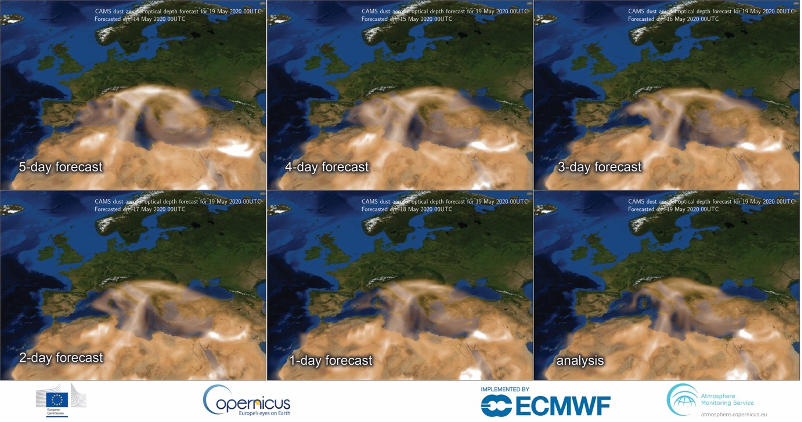
CAMS forecasts and analysis of the transport of Sahara dust to Europe on 19 May 2020. Credit: Copernicus Atmosphere Monitoring Service, ECMWF
CAMS forecasts and analysis of the transport of Sahara dust to Europe on 19 May 2020. Credit: Copernicus Atmosphere Monitoring Service, ECMWF
Dust storms and
climate change
More intense, less frequent
Dust transport from the Sahara to Europe is closely linked with the current and evolving state of the overall climate system.

In Europe, there are currently around 30 dust events every year, including 10 significant events, mostly during the spring and summer months.
Climate change is expected to increase temperatures and reduce precipitation over northern Africa, creating more arid regions. The amount of dust present will increase, creating situations where even larger uplift is possible.
As a result of changes like these, it is anticipated that dust storms will become less frequent but more intense. These intense dust storms will have further effects on the climate. For example, dust landing on the surface of glaciers cuts down the amount of solar radiation that is reflected back to the atmosphere and into space, and reducing the albedo effect. Global warming may therefore increase as a result.
Tracking and forecasting
dust storms
Producing and validating forecasts
CAMS tracks dust transport using satellite observations of Aerosol Optical Depth (AOD). AOD tells us how much sunlight is blocked by small solid particles or liquid droplets floating in the atmosphere.

CAMS uses these satellite observations as input to its forecasts, and also estimates the contribution to AOD of different components such as sea salt, desert dust, organic matter, black carbon and sulphate aerosols. CAMS AOD forecasts can be evaluated and validated against ground-based remote sensing.
Dust is composed of different sized particles suspended in the air, collectively known as particulate matter. CAMS calculates and validates two forms of particulate matter: PM10 (particles of 10 micrometres or less – coarse) and PM2.5 (particles of 2.5 micrometres or less – fine).
Particulate matter can penetrate deep into human lungs, leading to respiratory complications; but PM2.5 can also cross the air-blood barrier in the lungs. Increases in particulate matter are directly related to a fall in local air quality. It lowers visibility, and can damage organic and inorganic materials, including painted surfaces, metal, wood and plants. It can also leach nutrients from the soil, making it less productive and increasing the risk of crops succumbing to disease.

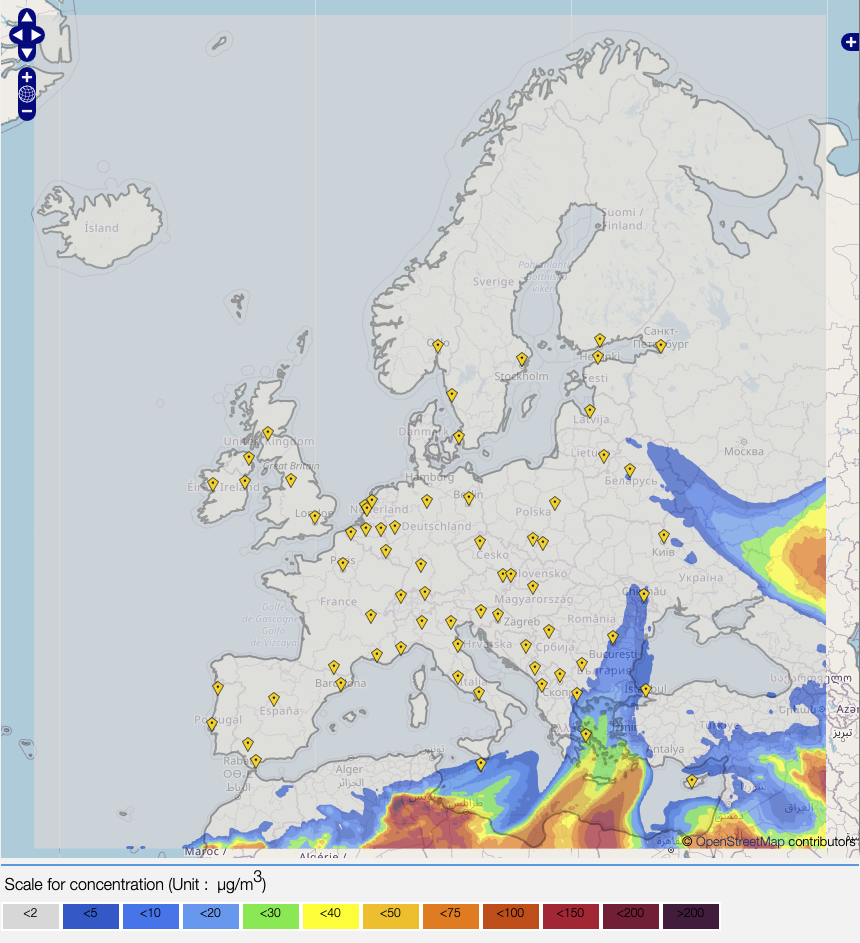
Map of daily maximum dust concentration over Europe on 9 December 2021 derived from the European air quality ensemble models. Credit: Copernicus Atmosphere Monitoring Service, ECMWF.
Map of daily maximum dust concentration over Europe on 9 December 2021 derived from the European air quality ensemble models. Credit: Copernicus Atmosphere Monitoring Service, ECMWF.
Dust forecasts for Europe…
CAMS uses an ensemble of European air quality models to produce extensive analyses and forecasts of air quality. The European ensemble is based on nine numerical air quality models created by organisations across Europe. Data on a variety of variables are provided, including PM2.5 and PM10 concentration, which are also regularly checked against observations taken at ground-based stations.
Link to CAMS European air quality forecasts dataset
The data are also provided in a simple visual format that allows users to select by variable, and to explore data for major European cities including capitals.
…and the globe
CAMS also provides global forecasts of atmospheric composition for more than 50 chemical species, again including dust.
Link to CAMS global atmospheric composition forecasts dataset
As well as the European and global quality-controlled datasets, which can be freely downloaded by any user, CAMS offers a range of easy-to-understand data visualisations.
SUPPORTING DECISION MAKING:
Accurate forecasts for Europe’s dust storms
Helping authorities plan ahead
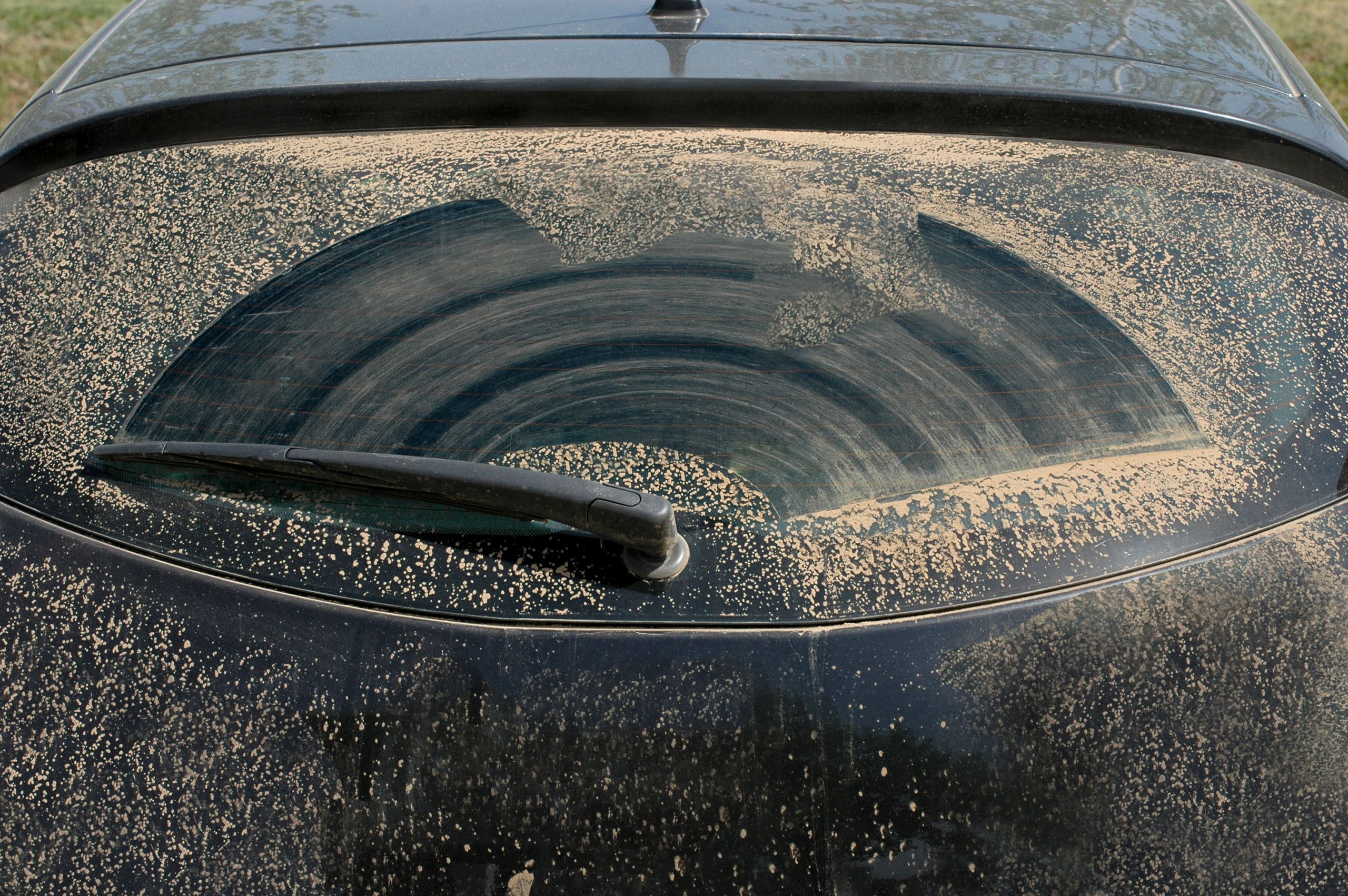
In February 2020, a dust storm originating in the Sahara grounded flights into and out of the Canary Islands. The plume was then carried across mainland Europe. CAMS forecasts tracked the particulate matter, helping businesses – in particular those in the transport sector – see how the dust storm would evolve.
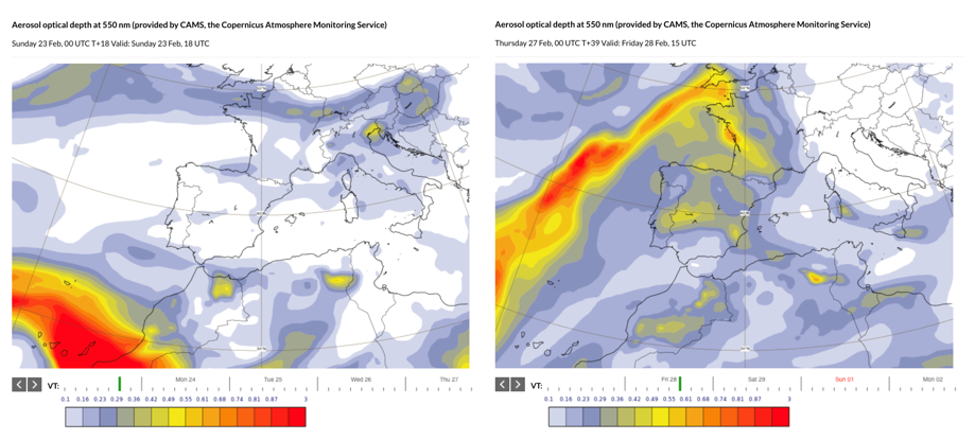
AOD forecast. Credit: Copernicus Atmosphere Monitoring Service, ECMWF.
AOD forecast. Credit: Copernicus Atmosphere Monitoring Service, ECMWF.
In February 2021, CAMS tracked another large Saharan dust episode that crossed the Mediterranean into Europe from northeast Algeria.
The forecasts showed the event several days in advance, warning local authorities about the arrival of a huge plume of dust and its potential effects on air quality.
Background images: CAMS AOD forecast. Credit: Copernicus Atmosphere Monitoring Service, ECMWF.
CAMS showed how the substantial dust plume would reach Europe over the weekend and linger into the following week. While the exact amount of dust was difficult to predict, CAMS forecasts revealed that the plume would be thick, with high AOD values and high concentrations of PM10.
CAMS predicted that the plume would continue across southern and western Europe, potentially disrupting solar power generation on the Iberian Peninsula, before continuing as far north as Norway.
Mark Parrington, CAMS senior scientist:
“Our forecasts were very reliable in describing the size and extent of the dust plume as well as its development and direction. It is remarkable how well the CAMS regional four-day and global five-day forecasts showed a very consistent shape and location of the dust cloud over the full range of the preceding day’s forecasts.”
By accurately forecasting and analysing the extent of dust storms, CAMS is contributing to the United Nations’ Sustainable Development Goals (SDGs).


SDG 3.9 aims to reduce the number of deaths and illnesses from air pollution by 2030. With effective forecasting of dust storms, authorities, communities and citizens can prepare for events a few days in advance and avoid them where possible.
This will also reduce the financial burdens on health services caused by respiratory ailments and other health problems.
Conclusion: Improving human health and supporting industry
CAMS forecasts are having positive effects on human health, by helping citizens and authorities to predict when harmful dust pollutants will enter the atmosphere and arrive in communities across the European continent and around the world.
The solar energy industry is seeing benefits from the CAMS forecasts by knowing in advance when dust clouds will block sunlight and dust deposition will cover solar panels. Effective management can help those in the solar energy sector not only protect their existing infrastructure, but plan where to build new plants.
Dust can affect transport links by covering railway tracks and overhead lines, and grounding planes. With forecasts up to five days in advance, the transport industry can also mitigate the effects by changing schedules and planning around the adverse weather.
CAMS is working to advance its capabilities in forecasting of dust. As this depends on a range of factors, including rainfall and wind patterns, it is a significant challenge.
CAMS principal scientist, Johannes Flemming, says: “In the future, we hope to attract experts who can process the information we provide to make it useful for a whole range of industries that are affected by the deposition of desert dust”.





